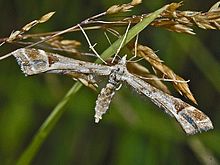Platyptilia gonodactyla
| Platyptilia gonodactyla | |
|---|---|
 |
|
| Platyptilia gonodactyla | |
| Scientific classification | |
| Kingdom: | Animalia |
| Class: | Insecta |
| Order: | Lepidoptera |
| Family: | Pterophoridae |
| Genus: | Platyptilia |
| Species: | P. gonodactyla |
| Binomial name | |
|
Platyptilia gonodactyla (Denis & Schiffermüller, 1775) |
|
| Synonyms | |
|
|
Platyptilia gonodactyla, common name triangle plume, is a moth of the family Pterophoroidea.
This species can be found in the Palearctic ecozone. It has a widespread distribution in Britain.
These moths inhabit open, grassy areas, waste ground, meadows and spruce forest edge.
The wingspan is 22–28 mm. They have pale brown or grayish wings with chestnut coloured markings towards the tips.
This species is very similar to Platyptilia nemoralis, but it shows a very small scaletooth at the dorsum of the third lobe.
The caterpillars are about six millimeters long at the end of March. They have a glossy black head and black mouthparts, prothoracal shield and thoracic legs. The body is yellow, with a broad reddish back.
The moths fly from May to October depending on the location. They are active at dusk and night. This species has two generation a year, in June and in late July-September.
The larvae feed on Tussilago and sometimes also Petasites. They mine the leaves of their host plant. The mine consists of a small, transparent, irregularly shaped full depth mine. There are often several mines in a single leaf. The frass is granular. There is little or it is missing completely. After some time the larvae leave the mines and continue feeding freely at the leaf underside or under a folded leaf margin.
...
Wikipedia
